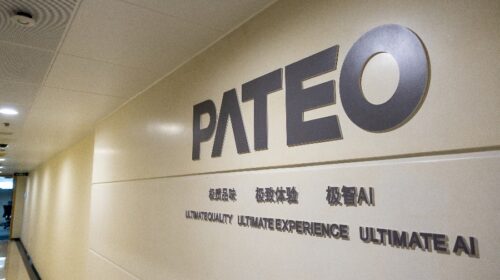SenseTime’s Profits Sucked Up Into R&D Vortex

Mounting research and development spending pushed SenseTime, one of China’s ‘Four AI Tigers,’ further into the loss column in the first half of the year
Key Takeaways:
- SenseTime spent up to 2 billion yuan on R&D in the first half of this year, equal to 144% of its total revenue
- Falling revenue from its two core businesses and delayed customer payments led the company to boost its impairment provisions by more than 50%
By Ken Lo
SenseTime Group Inc. (0020.HK) may be first among China’s four “AI Tigers.” But its healthy appetite for R&D spending looks set to keep it trapped in a sea of red ink for some time to come.
Of China’s top AI companies, SenseTime stands above its three biggest rivals, CloudWalk Technology (688327.SH), Megvii Technology and Yitu Technology, in computer vision artificial intelligence (AI). The company provides its technology to government and enterprise customers for applications like smart cities, surveillance and autonomous driving.
Its crown jewel is its SenseCore platform, which is backed by massive amounts of data and a deep learning algorithm that can provide services at a range of different levels and price points for various industries. SenseCore’s total computing capacity has been improved substantially as the company’s next-generation AI Data Center (AIDC) went into use in Shanghai earlier this year, enabling SenseTime to enter the race with global tech giants like Alphabet (GOOG.US) and Microsoft (MSFT.US) in computer vision AI. But SenseCore has also become a money sponge, and it’s far from clear the big R&D spending will result in enough new business to justify the expense.
The heavy R&D spending meant there was no magic turnaround for SenseTime’s money-bleeding interim results in this year’s first six months. During the period, the company lost a whopping 3.21 billion yuan ($465 million), which was lower than the year-ago 3.71 billion yuan loss. But its non-GAAP adjusted loss soared 265% to 2.56 billion yuan from a 703 million yuan loss in the same period of last year.
SenseTime said the flood of red ink owed mainly to its mounting R&D investment, combined with financial and contract asset impairments and foreign exchange losses.
Weak demand
SenseTime’s R&D spending has rocketed over the last four and a half year, ascending from 849 million yuan in 2018 to 3.61 billion yuan last year. It’s on track to stay on that trajectory this year after reaching 2.04 billion yuan in the first half of 2021 alone, positioning it to break through the 4-billion-yuan barrier for the whole year.
China’s continuing Covid control disruptions in the first half of this year dragged the company further down the deficit rabbit hole, with revenue down 14.3% year-on-year to 1.42 billion yuan. In the end, R&D spending made up 144% of the company’s revenue for the period, much higher than the average for large AI companies.
SenseTime noted in its report that control measures in several Chinese cities interrupted some customers’ spending plans for AI and related product deployments, and slowed down the company’s own smart city projects. As that happened, it decided to shift its growth focus to smart life and smart autos, which tend to be more focused in the private sector, and will drive more aggressively into those two segments in the second half of the year.
Among its four business segments, revenue for SenseTime’s smart business unit fell 12.2% year-on-year in the first half of 2022. Revenue for its smart city unit plunged 44.8%, creating the biggest drag on overall revenue. Its smaller smart life and smart auto businesses both performed much better, growing 97.6% and 71.1%, respectively. But that pair combined contributed less than 30% of the company’s total revenue.
Rising impairment provisions
Lockdowns and other control measures in several Chinese cities during the first half of the year not only delayed construction of smart city projects, but also prompted smart business customers to delay their AI-related spending. Delayed payments by such customers caused SenseTime’s receiveables due in 6 months to 1 year, and in 1 year to 2 years, to rise by more than 2 billion yuan. In anticipation that some of those won’t make their payments, the company set aside 1.5 billion yuan in impairment provisions, up by more than half compared with such provisions from the year-ago period.
Despite the cash-bleeding and higher impairment provisions, the company’s successful IPO last year meant it was still sitting on 19.51 billion yuan in cash, deposits, structured deposits, and bonds at the end of June.
But even if a cash crunch isn’t looming anytime soon, another major issue remains in the form of western sanctions. As the two examples we mentioned earlier illustrate, SenseTime has become a “focus company” for Washington due to its business supplying the central and local governments with its powerful surveillance technology.
As early as October 2019, American companies were banned from doing business with SenseTime’s Beijing unit. Washington then forced SenseTime to completely makeover its Hong Kong listing plan last year when it banned U.S. investors from buying into the IPO. The company still made it to market and was listed in Hong Kong at the end of December, with 1.5 billion shares issued, at HK$3.85, raising about HK$5.9 billion ($756 million).
Reflecting continued pressure from Washington, SenseTime suffered another blow last week when the U.S. also banned Nvidia (NVDA.US) and AMD (AMD.US) from selling their most cutting-edge AI chips to all Chinese customers.
SenseTime’s interim results did not discuss the latest impact of the U.S. sanctions on its business. But revenues from its overseas business reached 19% of the total, representing a 7.6 percentage point increase from the level for all of last year. But the change probably reflects declining revenue in China, rather than indicating the company’s overseas business is somehow free from influence by U.S. sanctions.
SenseTime’s shares have moved steadily downward this year after reaching a January high of HK$9.70, dropping as low as HK $2.04 on June 29, or nearly half of their issue price. Last Friday the stock closed at HK$2.26, giving it a market value of HK$76 billion.
SenseTime trades at a relatively low price-to-sales (P/S) ratio of just 4.2 times, less than half the 10.79 times for CloudWalk Technology. That could reflect concerns about SenseTime’s being singled out for sanctions by Washington, as well as investor concerns about its heavy R&D spending.
To subscribe to Bamboo Works weekly free newsletter, click here






